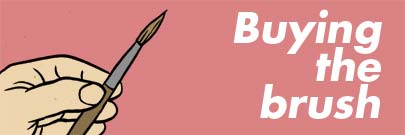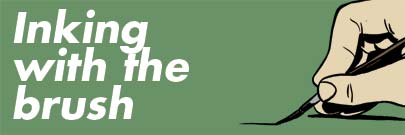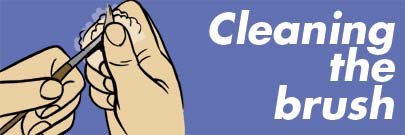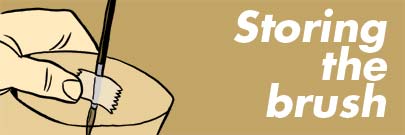Tips and Tricks: Brush Care
If you've ever mentioned to someone that you'd like to be a cartoonist and that you're wondering about what art supplies to get, chances are someone has suggested to you the Windsor and Newton Series 7 brush.
Made out of hair that was gently and no doubt painlessly harvested from adorable Russian sable minks, it's unquestionably the gold standard when it comes to comic-book inking. But one of the tricks of coaxing beautiful lines out of your brushes is knowing how to care for them.

These brushes are usually in a locked cabinet in the stores so you'll have to ask someone to get them out so you can look at them. If they'll let you, dip the bristles into some water and flick it on the floor. Did the brush split? Don't get it. It'll split when you ink, too. If it keeps its point, it's good. Give them your money.
Our buddy Gene Ha draws notoriously tiny details with his brushes (yes, he uses the same brushes as everyone else, he just has a steadier hand) and here's his trick. He asks at the store if he can buy a set of three brushes in the original pack. They're shipped in airtight packs of 3, and if you get them like that, you can catch them before they've been messed with and exposed to light and air and all that. He then keeps the other two in a ziplock bag in the fridge with a wet paper towel to keep them moist. Seem excessive? Welcome to the world of Gene Ha.

Everyone has a different opinion about this. Here's mine. When I start inking, I set a clock in my head. The brush can't be out of ink or water for more than about a minute. It's stressful, but it really pays off in the long run. You also get a lot of inking done when you can't put down your brush for a sandwich.
I also always dip my brush in so that the ink goes up past the hairs and onto the metal. Every time. This way the ink in the brush always stays wet and it keeps the hairs of the brush all moving uniformly. I used to be afraid of getting ink inside the metal ferrule and so I would only dip the brush halfway down. One, this never worked. I would always, on about the 50th dip, dip too far down and everything was shot to hell. Two, even if I didn't make that mistake, the capillary action of the hairs would draw the ink up into the ferrule anyway. So I figured I'd just keep the brush wet and then wash it out really well. That's worked for me for years.

Brushes are hair, so you can clean them a lot of different ways. I used to use regular bar soap, then I used shampoo, then I used shampoo and conditioner (which was starting to feel pretty silly), then I found the perfect solution. "The Masters" Brush Cleaner and Preserver. Never use anything else. It's cheap and you can get it at any art supply store. It completely cleans out your brush and conditions the hair so that it keeps a perfect point.
By the time I'm going to wash out my brush, it's gotten pretty filthy, so the whole process takes a few minutes. I get plenty of the soap on my fingers, then work it into the bristles, always pushing towards the tip of the brush. I take care not to smash the hairs down and try to more or less just bend them back and forth, spreading them gently apart and just trying to get the hairs of the brush brown again. Repeat this a couple times, and when the soap is staying pretty much white, you've got a clean brush.
One more step. Once the brush is clean, put in a little more soap, get the tip to a fine, sharp point, and leave it in. It'll make the brush stiff and keep it from getting frizzy between now and whenever you use the brush again.

At art supply stores you can find these things that look like stretched-out springs on a stand, and you're meant to stick your brushes into them so that they hang upside down, all the better for keeping the points. I don't have one of those, but I probably should get one. When I store my brushes upside down, I usually tape them to the inside of an empty water glass. I use the same trick with a full glass if the doorbell rings and I have to stop inking and I don't want the brush to dry out.
Other brushes are pretty good as well, but they never come that cheap. Unless you're willing to do a lot of experimenting, you may as well stick with the gold standard.
Happy Inking!
Labels: Tips and Tricks

3 Comments:
It's a horrible world where you can't stop working to have a sandwich. Especially if it's a World Famous Donn Ha Korean BBQ Pork Sandwich(tm).
what's about the usual brush life span for you?
One that I take care of like I mentioned should last 2-3 years of constant use. They start getting a bit frizzy and discolored after that.
That said, I haven't done anything close to scientific testing on this, and I haven't used a brush like this heavily, or on a daily basis, for a while.
And that calculation's for the brush being your primary brush. Whenever brushes wouldn't hold that ABSOLUTELY PERFECT line, they would get demoted to filling large black areas or sketching or whatever, and last basically forever, since the demands on them are not nearly as rigorous.
Post a Comment
<< Home